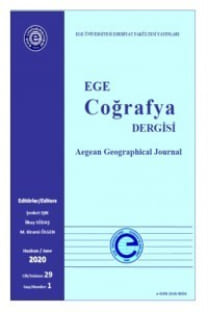INVESTIGATION OF QUESTION TYPES IN HIGH SCHOOL GEOGRAPHY COURSEBOOKS AND THEIR ANALYSIS IN ACCORDANCE WITH THE REVISED BLOOM’S TAXONOMY
Geography, Revised Bloom’s Taxonomy, coursebook, Revised Bloom’s Taxonomy, question types, assessment tools
INVESTIGATION OF QUESTION TYPES IN HIGH SCHOOL GEOGRAPHY COURSEBOOKS AND THEIR ANALYSIS IN ACCORDANCE WITH THE REVISED BLOOM’S TAXONOMY
Geography, coursebook, Revised Bloom’s Taxonomy, question types, assessment tools,
___
- Anderson, I. L. & Horney, M. (1997). Computer Based Concept Mapping: Enhancing Literacy With Tools For Visual Thinking. Journal of Adolescent Adult Literacy,40 (4), 302-308.
- Anderson, L. W. & Krathwohl, D. R., et al (Eds.) (2001) A Taxonomy for Learning, Teaching, and Assessing: A Revision of Bloom’s Taxonomy of Educational Objectives. Allyn & Bacon. Boston, MA (Pearson Education Group).
- Arı, A (2011). Bloom’un Gözden Geçirilmiş Bilişsel Alan Taksonomisinin Türkiye’de ve Uluslararası Alanda Kabul Görme Durumu. Kuram ve Uygulamada Eğitim Bilimleri, 11 (2), 749-772.
- Arı, A. & Gökler, Z. S. (2012). İlköğretim fen ve teknoloji dersi kazanımları ve SBS sorularının yeni Bloom taksonomisine göre değerlendirilmesi. X. Ulusal Fen Bilimleri ve Matematik Eğitimi Kongresi (pp. 20-30). Niğde. Haziran 2012.
- Arslan, S. & Özpınar, S. (2009). İlköğretim 6. Sınıf Matematik Ders Kitaplarının Öğretmen Görüşleri Doğrultusunda Değerlendirilmesi, Dicle Üniversitesi Ziya Gökalp Eğitim Fakültesi Dergisi, 12, 97-113.
- Atılgan, H., Kan, A. & Doğan, N. (2011). Eğitimde Ölçme ve Değerlendirme. (5.Baskı) Ankara: Anı Yayıncılık.
- Biber, Ç.A. &Tuna, A. (2017). Ortaokul Matematik Kitaplarındaki Öğrenme Alanları ve Bloom Taksonomisine Göre Karşılaştırmalı Analizi, Ondokuz Mayıs Üniversitesi Eğitim Fakültesi Dergisi, 36(1), 161-174.
- Brualdi, A.C. (1998). Classroomquestions, practicalassessment. Research & Evaluation, 6, Eric Documentre production no: ED 422407.
- Çalışkan, H. (2011). Öğretmenlerin Hazırladığı Sosyal Bilgiler Dersi Sınav Sorularının Değerlendirilmesi, Eğitim ve Bilim, 36 (160), 120-132.
- Demir, P. (2015). Yenilenmiş Bloom Taksonomisi'ne göre 2005 yılı sosyal bilgiler öğretim programında yer alan kazanımlar ve seviye belirleme sınav soruları (Yayınlanmamış Yüksek lisans tezi), Ondokuz Mayıs Üniversitesi, Eğitim Bilimleri Enstitüsü, Samsun.
- Demirel, Ö. (1999). Eğitimde Program Geliştirme, Ankara: Pegem A Yayıncılık Akademi
- Dindar, H. & Demir, M. (2006). Beşinci sınıf öğretmenlerinin fen bilgisi dersi sınav sorularının bloom taksonomisine göre değerlendirilmesi, Gazi Üniversitesi Gazi Eğitim Fakültesi Dergisi, 26 (3), 87-96.
- Dursun, A. & Parim-Aydın.G., (2014). YGS 2013 Matematik Soruları İle Ortaöğretim 9. Sınıf Matematik Sınav Sorularının Bloom Taksonomisine ve Öğretim Programına Göre Karşılaştırılması, Eğitim Bilimleri Araştırmaları Dergisi, 4(1), 16-37.
- Durukan, E. & Demir, E. (2017). 6, 7 ve 8. Sınıf Türkçe Dersi Öğrenci Çalışma Kitaplarındaki Etkinliklerin Bloom’un Yenilenmiş Taksonomisine Göre Sınıflandırılması. Uluslararası Türkçe Edebiyat Kültür Eğitim Dergisi, 6(3), 1619-1629.Eke, C. (2015). Dalgalar Ünitesindeki Kazanımların Yenilenmiş Bloom Taksonomisine Göre İncelenmesi. Eğitim ve Öğretim Araştırmaları Dergisi, 4 (2), 345-353.
- Enger, S.K. & Yager, R.E. (1998). Iowa assessment handbook. Iowa City: Science Education Center, The University of Iowa.
- Geçit, Y. & Yarar, S. (2010). 9.Sınıf Coğrafya Ders Kitabındaki Sorular ile Çeşitli Coğrafya Sınav Sorularının Bloom Taksonomisine Göre Analizi, Marmara Coğrafya Dergisi, 22, 154-167.
- Gezer, M., Şahin, Ġ. F., Öner-Sünkür, M. & Meral, E. (2014). 8. Sınıf Türkiye Cumhuriyeti İnkılâp Tarihi ve Atatürkçülük Dersi Öğretim Programı Kazanımlarının Revize Edilmiş Bloom Taksonomisine Göre Değerlendirilmesi, Bartın Üniversitesi Eğitim Fakültesi Dergisi, 3 (1), 433-455.
- Güleryüz, H. (2016). 5., 6., 7., Sınıfların fen ve teknoloji dersine ait sınav sorularının Bloom taksonomisine göre değerlendirilmesi (Yayınlanmamış Yüksek lisans tezi), Muş Alpaslan Üniversitesi, Fen Bilimleri Enstitüsü, Muş.
- Karadeniz, O., Eker, C. & Burunsuz, E. (2015). Ortaokul Sosyal Bilgiler Dersi Öğretim Programı Kazanımlarının Yapılandırmacı Öğrenme Kuramı İlkelerine Göre Değerlendirilmesi, International Periodical For The Languages, Literatureand History of Turkish. 10 (3), 563-580.
- Manning, M & Gary, M. (1995). Portfolios in Readingand Writing. Teaching Pre K-8, 25 (5), 94-95.
- MEB. (2005). Coğrafya Dersi Öğretim Programı. Ankara: Devlet Kitapları Basım Evi.
- Näsström, G. (2009). Interpretation of Standards with Bloom’s Revised Taxonomy: A comparison of teachers and assessmentex perts, Gunilla International Journal of Research &.Method in Education, 32(1), 39-51.
- Karasar, N.(2007). Bilimsel Araştırma Yöntemi, Nobel Yayın Dağıtım, Ankara.
- Özcan, S. & Açık, F. (2011). SBS Türkçe Sorularıyla Türkçe Ders Kitaplarındaki Soruların Örtüşme Düzeyi, Uluslararası Sosyal Araştırmalar Dergisi, 4 (16),355-370.
- Semerci, Ç. (2011). Eğitimde ölçme ve değerlendirme. (Ed. Karip E.). Ölçme ve Değerlendirme. Ankara: Pegem Akademi.
- Smaldino E. S., Russell D. J., Heinich R. &Molenda M. (2005). Instructional Technology and Media For Learning. (3th edit.). New Jersey, Merrill Prentice Hall.
- Şanlı, C., Pınar, A. (2017). Sosyal Bilgiler Dersi Sınav Sorularının Yenilenen Bloom Taksonomisine Göre İncelenmesi. İlköğretim Online, 16(3), 949-959.
- Tahaoğlu, A., (2014). Ortaöğretim Türk edebiyatı dersi öğretim programı kazanımlarının bilişsel açıdan incelenmesi (Yayınlanmamış Yüksek lisans tezi), Bilkent Üniversitesi, Eğitim Bilimleri Enstitüsü, Ankara.
- Tan, Ş., & Erdoğan, A. (2004). Öğretimi planlama ve değerlendirme. Ankara: PegemA Yayıncılık.
- Tekin, H. (1993). Eğitimde Ölçme ve Değerlendirme, Ankara: Yargı Yayınevi.
- Turgut, M.F. & Baykul Y. (2012). Eğitimde Ölçme ve Değerlendirme. Ankara: Pegem Yayıncılık.
- Ulum, H. (2017). MEB ilkokul 2, 3 ve 4.sınıf Türkçe ders ve çalışma kitaplarında yer alan etkinliklerin yenilenmiş Bloom taksonomisine göre incelenmesi (Yayınlanmamış Yüksek lisans tezi), Mersin Üniversitesi Eğitim Bilimleri Enstitüsü, Mersin.
- Üner, S., Akkuş, H. & Kormalı, F.(2014). Ortaöğretim Kimya Ders Kitaplarındaki ve Sınavlarındaki Soruların Bilişsel Düzeyi ve Öğrencilerin Bilişsel Düzeyiyle İlişkisi, Ahi Evran Üniversitesi Kırşehir Eğitim Fakültesi Dergisi, 15(1), 137-154.
- Ünlü, S., Öztürk, H. & Tağa, T. (2014). Türkçe Dersinde Uygulanan Sınavlar Üzerine Bir Değerlendirme, The Journal of Akademic Social Science Studies, 28 (2), 513-523.
- Yıldırım, A. ve Şimşek, H. (2011). Sosyal Bilimlerde Nitel Araştırma Yöntemleri. (8. Baski). Ankara: Seçkin Yayıncılık.
- Yayın Aralığı: 2
- Başlangıç: 1983
- Yayıncı: Prof. Dr. Şevket IŞIK
TÜRKİYE’DE YABANCI NÜFUSUN YENİ COĞRAFYALARI
DESTİNASYON MARKALAŞMASINDA GASTRONOMİK ÜRÜNLERİN ROLÜ: BAFRA İLÇESİ ÖRNEĞİ
Mutlu KAYA, Melike ÇAKIR KELEŞ
MANYAS (KUŞ) GÖLÜNDE (BALIKESİR) SU ÜRÜNLERİ AVCILIĞI: KÜLTÜR, EKOLOJİ VE SÜRDÜRÜLEBİLİRLİK
TURİZMİN MARDİN ESKİ KENT DOKUSUNA ETKİSİ
Mesut ŞİMŞEK, Mustafa UTLU, Murat POYRAZ, Muhammed Zeynel ÖZTÜRK
